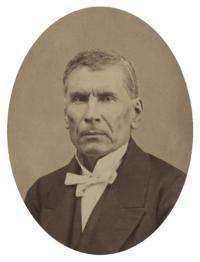Santiago Vidaurri

Jan 12, 1832 was the year Santiago turned twenty-four, and the year he was thrown in jail. He was at a bar with friends when Juan Olivares, an unruly soldier began causing trouble. The soldier started harassing the town drunk – who was defenseless and belligerent. Santiago seeing the situation escalate stepped in – knowing that if he stood by and watched the soldier would end up killing the poor belligerent man.
The brawl between Santiago and the soldier was hard-fought and grueling. Santiago’s intention was not to kill the soldier but to simply render him powerless. Santiago did not believe in wasting human life and struggled not to injure the soldier. The soldier had other intentions – he wanted to kill Santiago. Santiago was given no choice but to sever the soldier’s hand – it was in self-defense. There were men at the bar that evening that disliked Santiago and testified otherwise.
During a conversation, Santiago overheard the prison guard’s debate over a letter the warden dictated to them. Offering his services, mainly because he was bored Santiago wrote their letter. Once Santiago was released he was given the job of chief clerk in the municipal jail. It did not take long for Santiago to receive more responsibility; he started signing off on official documents for Dn. Pedro de Valle.
In 1837 Santiago was promoted to secretary-general to Joaquin Garcia – Mexico found herself once again in turmoil, in 1841 a group of Generals ousted President Busamantes and replaced the Governor of Nuevo León with Manuela Maria Llano – Santiago then became his secretary and was chosen by General Arista to spy for the Santa Fe expedition. This expedition was sponsored by President Mirabeau B. Lamar. The purpose was to divert the Santa Fe Trail into Texas and establish control over New Mexico. Santiago proved to be very efficient as he was in everything he undertook.
The revolution of Ayutla began in the early months of 1855 – it was a movement based on the declaration of independence and the liberal constitution of 1824. It was written by Juan Alvarez and Ignacio Commonfort.
It was during this time that Santiago developed influence over a group of political newcomers – he often met in secret with Antonio Rosales and other liberal leaders. Their group included Ignacio Zaragoza, Jose Silvestri Aramberri, Lazaro Garza Ayala, Francisco Naranjo and Juan Zuazua. The reason for these secret meetings was because everyone was tired of the unstable government that plagued the northern states. Their chief aim was to rid Mexico of the negative influences that took advantage of the poverty-stricken population. Santiago was a leader by birth – he was appointed the groups political chief.
The momentum for Ayutla began slowly as Antonio Lopez de Santa Anna was desperately clinging to his position. He was hoping to discredit the liberals with anticlericalism. The revolution of Ayutal then gained the necessary speed it needed when it was joined by Santos Degollado and Manuel Doblado.
Santiago never to miss an opportunity along with Juan Zuazua issued out a plan “Restaudor de la Libertad.” On May 22, 1855 Santiago was proclaimed Governor and military commander of Nuevo León and Juan Zuazua was appointed Colonial of the states army. This became the beginning of El Vidaurrismo, it was more than just a political movement, and it was a way of thinking a way of life.
Santiago’s aim was to bring la restaurdor de the libertad to all of Mexico – he proceeded to establish himself in local and national politics. With the victory of the northerners – the people of Nuevo León were now guaranteed property, security and a stable and enlightened government. Los Vidaurristas infiltrated Tammaulipas and Santiago annexed Coahuila in Feb 12 1856.
Santiago grew up to have more power than anyone including his family would have ever imagined. He had sole control of Coahuila, Tamaulipas, San Luis Potosí, Chihuahua and Durango. And on February 19, 1856, he annexed Coahuila into that of Nuevo León. He had complete power over Northern Mexico – more than any man hoped to ever have. Once Ayutla was established he began his attention on frontier politics. He was a political and economic liberal, which was unheard of. In the 19th century most liberals were usually one or the other. Santiago was progressive and favored federalism and admired the government of the United States and used it as a role model for his Northern States.
He knew that trade with Texas was easier and more profitable than with the interior of Mexico City. He believed in taking individual initiative and free economy from government interference. If Nuevo León was going to be prosperous he needed a free hand – this being the real reason he banned the church from any interference.
Notes: Not finished For More Information @LosVidaurri.com
|